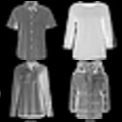In 2019 Kerdels and Peters proposed a grid cell model (GCM) based on a Differential Growing Neural Gas (DGNG) network architecture as a computationally efficient way to model an Autoassociative Memory Cell (AMC) \cite{Kerdels_Peters_2019}. An important feature of the DGNG architecture with respect to possible applications in the field of computational neuroscience is its \textit{capacity} refering to its capability to process and uniquely distinguish input signals and therefore obtain a valid representation of the input space. This study evaluates the capacity of a two layered DGNG grid cell model on the Fashion-MNIST dataset. The focus on the study lies on the variation of layer sizes to improve the understanding of capacity properties in relation to network parameters as well as its scaling properties. Additionally, parameter discussions and a plausability check with a pixel/segment variation method are provided. It is concluded, that the DGNG model is able to obtain a meaningful and plausible representation of the input space and to cope with the complexity of the Fashion-MNIST dataset even at moderate layer sizes.
翻译:2019年,凯尔德尔斯和彼得斯提出了基于不同增长神经气体(DGNG)网络结构的网格单元模型(GCM),作为模拟自动联合内存细胞(AMC)的计算高效方法。DGN结构在计算神经科学领域可能应用方面的一个重要特征是其处理能力和独特区分输入信号的能力,因此获得输入空间的有效代表。这项研究评估了两个分层的DGNG网格模型在时装-MNIST数据集上的能力。研究的重点是各层的变换,以提高对网络参数及其缩放特性的能力特性的理解。此外,提供了参数讨论和与等离子/分系变异方法的概率检查。得出的结论是,DGNG模型能够获得输入空间的有意义和可信的代表,并能够在中层适应Fashion-MISG数据集的复杂性。



